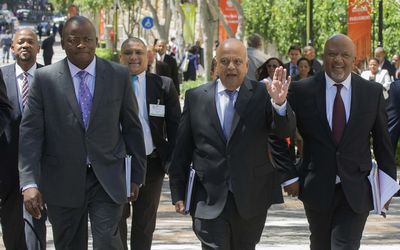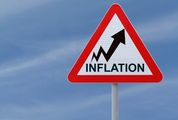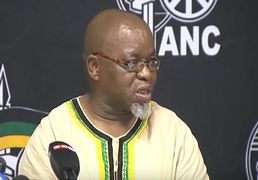Belt tightening only the first step, says Gordhan
by Linda Ensor, Ntsakisi Maswanganyi, Carol Paton, Hilary Joffe and Sam Mkokeli,
2016-02-25 05:52:54.0
FINANCE Minister Pravin Gordhan tabled on Wednesday a budget that stepped up the pace of fiscal consolidation by slowing spending and raising taxes as he made a brave effort to avert a downgrade in SA’s credit ratings to junk status and reignite the faltering economy.
However, his room for manoeuvre was limited due to a rapidly slowing economy.
As part of a plan to force greater efficiency in state spending, as many as 20,000 jobs could be shed in the next three years with the Treasury imposing a "lock" on the government payroll system that will prevent departments and provincial governments making new hires, unless approved. This is expected to cut the wage bill by R7.2bn over this period.
Mr Gordhan called on SA to remain resilient in tough economic times. He expressly said his budget was not an austerity one but he had just tightened the belt "one notch".
Moody’s Investors Service senior vice-president Kristin Lindow said the budget "aims at delivering faster fiscal consolidation in part by cutting the large civil servant wage bill while preserving growth-supporting capital spending".
"Moody’s also views the planned tax increases as well-targeted given the weak economic backdrop."
But she said the specific measures that would reduce the deficits for the next two financial years had not been identified.
The revised growth forecasts of 0.9% and 1.7% were more optimistic than Moody’s own predictions of 0.5% for 2016 and 1.5% for 2017, she said. Cuts in expenditure on goods and services are anticipated to save R5bn in the period while the centralisation of government procurement under the chief procurement officer is expected to save R25bn a year by 2018-19.
Taxpayers who have undeclared offshore assets and income have six months to regularise their affairs in exchange for income tax and exchange control relief.
Mr Gordhan announced cutbacks on spending on ministerial cars which have cost up to R1.2m in the past. Public Service and Administration Minister Ngoako Ramatlhodi said the new ministerial handbook would cap this expenditure at R750,000.
But some economists believe that the minister did not go far enough and have warned that the fiscal consolidation plans he outlined rested on a fragile foundation of overly optimistic economic growth projections.
The Treasury has forecast economic growth of 0.9% this year, 1.7% for 2017-18 and 2.4% for 2018-19, forecasts which Pan African Capital Holdings CE Iraj Abedian has dismissed as "dreaming". A "disappointed" BNP Paribas economist Jeffrey Schultz and Capital Economics senior emerging markets economist William Jackson also agreed the growth projections were optimistic. The government would struggle to meet its budget deficit targets.
The Treasury is planning a much faster reduction in the budget deficit than envisaged in the medium-term budget policy statement (MTBPS). The deficit is projected to fall to 3.2% in 2016-17, 2.8% in 2017-18 and 2.4% in 2018-19 compared to the MTBPS which forecast a deficit of 3.3% in 2016-17, 3.2% in 2017-18 and 3% in 2018-19.
The package included a higher tax burden for all, except low to middle income earners, a R6.8bn increase in the fuel levy and a lower rate of growth in government expenditure. These will enable the Treasury to fill the holes left in its budget by lower revenue collection.
Personal income tax relief of R5.5bn has been granted which is R7.6bn less than the R13.1bn that would have been required to account fully for fiscal drag.
The general fuel levy rises by 30c/l raising R6.8bn more for the fiscus, while increased duty on alcohol and tobacco will bring in R2.3bn more.
The real pain will come in later years as the Treasury plans to reduce the budget deficit at a much faster pace than previously projected as from next year. Expenditure will be cut by R10bn in 2017-18 and R15bn in 2018-19 while tax increases of R15bn in 2017-18 and R15bn the following year are planned.
The state’s infrastructure programme is expected to contribute to economic growth. The public sector will invest R870bn in transport, energy, housing, health and water infrastructure over the next three years.
Real growth in state non-interest expenditure is maintained at 0.2% this year. In the next three years state expenditure will grow in real terms at an average of 0.8% annually. Mr Gordhan emphasised at a media briefing before his speech that there would not be austerity and cuts of social grants and other essential services were not on the agenda. However, government programmes would be reviewed to see if they were necessary or whether their implementation could be delayed.
A reprioritisation of R31.8bn in allocations has been made over the next three years to cover the needs of higher education, the drought and the government’s commitment to the New Development Bank.
Debt service costs remain the fastest item of expenditure consuming 12c of every rand of state revenue. They are projected at R147.7bn in 2016-17 and R161.9bn and R178.6bn for the next two years respectively.
Despite the government’s repeated commitment to rein in debt, the ratio of total gross loan debt as a percentage of gross domestic product will reach 51% in 2017-18 before falling to 50.5% the following year. The public sector borrowing requirement is anticipated at R221.6bn for 2016-17.
The contingency reserve has also been boosted by R3bn to R6bn in 2016-17 and R10bn and R15bn in the following two years compared with the R2.5bn, R9bn and R15bn respectively provided for in the MTBPS.

Finance Minister Pravin Gordhan, flanked by deputy minister Mcebisi Jonas, right, and Treasury director-general Lungisa Fuzile, left, and Deputy Finance Minister Mcebisi Jonas, arrive at Parliament on Wednesday. Picture: TREVOR SAMSON
FINANCE Minister Pravin Gordhan tabled on Wednesday a budget that stepped up the pace of fiscal consolidation by slowing spending and raising taxes as he made a brave effort to avert a downgrade in SA’s credit ratings to junk status and reignite the faltering economy.
However, his room for manoeuvre was limited due to a rapidly slowing economy.
As part of a plan to force greater efficiency in state spending, as many as 20,000 jobs could be shed in the next three years with the Treasury imposing a "lock" on the government payroll system that will prevent departments and provincial governments making new hires, unless approved. This is expected to cut the wage bill by R7.2bn over this period.
Mr Gordhan called on SA to remain resilient in tough economic times. He expressly said his budget was not an austerity one but he had just tightened the belt "one notch".
Moody’s Investors Service senior vice-president Kristin Lindow said the budget "aims at delivering faster fiscal consolidation in part by cutting the large civil servant wage bill while preserving growth-supporting capital spending".
"Moody’s also views the planned tax increases as well-targeted given the weak economic backdrop."
But she said the specific measures that would reduce the deficits for the next two financial years had not been identified.
The revised growth forecasts of 0.9% and 1.7% were more optimistic than Moody’s own predictions of 0.5% for 2016 and 1.5% for 2017, she said. Cuts in expenditure on goods and services are anticipated to save R5bn in the period while the centralisation of government procurement under the chief procurement officer is expected to save R25bn a year by 2018-19.
Taxpayers who have undeclared offshore assets and income have six months to regularise their affairs in exchange for income tax and exchange control relief.
Mr Gordhan announced cutbacks on spending on ministerial cars which have cost up to R1.2m in the past. Public Service and Administration Minister Ngoako Ramatlhodi said the new ministerial handbook would cap this expenditure at R750,000.
But some economists believe that the minister did not go far enough and have warned that the fiscal consolidation plans he outlined rested on a fragile foundation of overly optimistic economic growth projections.
The Treasury has forecast economic growth of 0.9% this year, 1.7% for 2017-18 and 2.4% for 2018-19, forecasts which Pan African Capital Holdings CE Iraj Abedian has dismissed as "dreaming". A "disappointed" BNP Paribas economist Jeffrey Schultz and Capital Economics senior emerging markets economist William Jackson also agreed the growth projections were optimistic. The government would struggle to meet its budget deficit targets.
The Treasury is planning a much faster reduction in the budget deficit than envisaged in the medium-term budget policy statement (MTBPS). The deficit is projected to fall to 3.2% in 2016-17, 2.8% in 2017-18 and 2.4% in 2018-19 compared to the MTBPS which forecast a deficit of 3.3% in 2016-17, 3.2% in 2017-18 and 3% in 2018-19.
The package included a higher tax burden for all, except low to middle income earners, a R6.8bn increase in the fuel levy and a lower rate of growth in government expenditure. These will enable the Treasury to fill the holes left in its budget by lower revenue collection.
Personal income tax relief of R5.5bn has been granted which is R7.6bn less than the R13.1bn that would have been required to account fully for fiscal drag.
The general fuel levy rises by 30c/l raising R6.8bn more for the fiscus, while increased duty on alcohol and tobacco will bring in R2.3bn more.
The real pain will come in later years as the Treasury plans to reduce the budget deficit at a much faster pace than previously projected as from next year. Expenditure will be cut by R10bn in 2017-18 and R15bn in 2018-19 while tax increases of R15bn in 2017-18 and R15bn the following year are planned.
The state’s infrastructure programme is expected to contribute to economic growth. The public sector will invest R870bn in transport, energy, housing, health and water infrastructure over the next three years.
Real growth in state non-interest expenditure is maintained at 0.2% this year. In the next three years state expenditure will grow in real terms at an average of 0.8% annually. Mr Gordhan emphasised at a media briefing before his speech that there would not be austerity and cuts of social grants and other essential services were not on the agenda. However, government programmes would be reviewed to see if they were necessary or whether their implementation could be delayed.
A reprioritisation of R31.8bn in allocations has been made over the next three years to cover the needs of higher education, the drought and the government’s commitment to the New Development Bank.
Debt service costs remain the fastest item of expenditure consuming 12c of every rand of state revenue. They are projected at R147.7bn in 2016-17 and R161.9bn and R178.6bn for the next two years respectively.
Despite the government’s repeated commitment to rein in debt, the ratio of total gross loan debt as a percentage of gross domestic product will reach 51% in 2017-18 before falling to 50.5% the following year. The public sector borrowing requirement is anticipated at R221.6bn for 2016-17.
The contingency reserve has also been boosted by R3bn to R6bn in 2016-17 and R10bn and R15bn in the following two years compared with the R2.5bn, R9bn and R15bn respectively provided for in the MTBPS.













 News, views and analysis of Finance Minister Pravin Gordhan's 2016 budget
News, views and analysis of Finance Minister Pravin Gordhan's 2016 budget













Change: -0.47%
Change: -0.57%
Change: -1.76%
Change: -0.34%
Change: 0.02%
Data supplied by Profile Data
Change: -1.49%
Change: 0.08%
Change: -0.47%
Change: 0.00%
Change: -0.04%
Data supplied by Profile Data
Change: -0.34%
Change: 0.03%
Change: -0.10%
Change: -0.22%
Change: -0.81%
Data supplied by Profile Data
Change: -0.28%
Change: -1.15%
Change: -0.07%
Change: -1.21%
Change: -0.22%
Data supplied by Profile Data